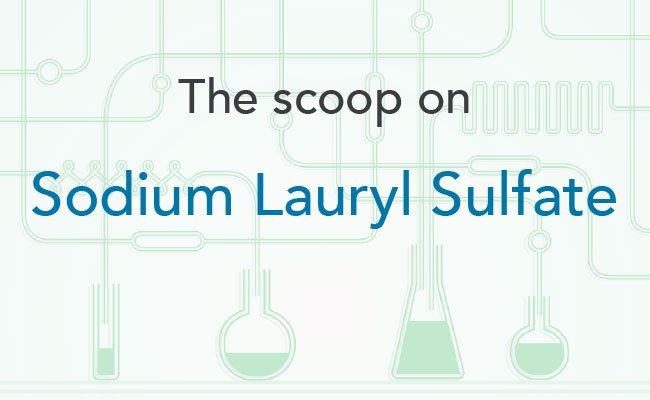What is Sodium Lauryl Sulfate: Chemical Free Living

Toxic Chemical Glossary:
What is Sodium Lauryl Sulfate: Chemical Free Living
What is sodium lauryl sulfate?
Sodium lauryl sulfate is a denaturant and surfactant. It is the sodium salt of lauryl sulfate used as a cleaning agent that produces foam in a variety of household and personal care products [1]. Sodium lauryl sulfate is used to increase cleaning power by increasing the product’s foaming power [4].
What products is sodium lauryl sulfate in?
Sodium lauryl sulfate is found in household cleaners, toothpastes, soaps, shampoos, and laundry detergents. It is also used as a food additive and as an engine degreaser [2] [3] [4].
How to tell if a product has methylisothiazolinone
Products that contain sodium lauryl sulfate may list this ingredient using different names. Synonyms for sodium lauryl sulfate include the following:
sulfuric acid monododecyl ester sodium salt; sodium lauryl sulfate; monododecyl ester sodium salt sulfuric acid; sodium dodecyl sulfate; sodium dodecyl sulphate; sodium salt sulfuric acid, monododecyl ester; sulfic acid, monododecyl ester, sodium salt; AI3-00356; akyposal sds; aquarex me; aquarex methyl [1].
Risks associated with sodium lauryl sulfate
Sodium lauryl sulfate can cause irritation to the eyes, lungs, and skin [4] [1]. It’s also hazardous to the environment, particularly aquatic life [4]. Studies on sodium lauryl sulfate have shown concerns about non-reproductive organ system toxicity [1]. Aerosolized products that contain sodium lauryl sulfate or that are used around the eyes and skin have been classified as human irritants by Cosmetic Ingredient Review Assessments [1]. Some studies have shown that sodium lauryl sulfate can cause developmental, endocrine, or reproductive issues [2].
The CDC lists several negative health effects that can occur as a result of exposure to sodium lauryl sulfate depending on the type of exposure. When this ingredient is inhaled, it can cause coughing and a sore throat [5]. Contact with the skin or eyes can cause redness or pain [5]. Ingesting sodium lauryl sulfate can lead to nausea, vomiting, or diarrhea [5].
How to avoid sodium lauryl sulfate
It is possible to avoid sodium lauryl sulfate and find toxic chemical free household cleaners and personal care products that are just as effective. There are shampoos and toothpaste formulations that are free of sodium lauryl sulfate [4]. Look at the ingredient labels and avoid products that list this ingredient or any of its synonyms:
sulfuric acid monododecyl ester sodium salt; sodium lauryl sulfate sodium lauryl sulfate; monododecyl ester sodium salt sulfuric acid; sodium dodecyl sulfate; sodium dodecyl sulphate; sodium salt sulfuric acid, monododecyl ester; sulfic acid, monododecyl ester, sodium salt; AI3-00356; akyposal sds; aquarex me; aquarex methyl [1].
In personal care products, do your own research on a product’s ingredients by using a resource such as the Environmental Working Group’s Skin Deep product database.
Note that many so-called “natural” cleaning products contain sodium lauryl sulfate because there are no federal standards dictating what makes a cleaning product natural. Remember that cleaning product manufacturers do not have to list all the product’s ingredients on their labels, so this ingredient may not even be listed. To be safe when buying cleaning products, choose toxic chemical free alternatives with safe natural ingredients.
References:
- EWG’s Skin Deep Cosmetics Database (2007-2017). Sodium Lauryl Sulfate. Available online: https://www.ewg.org/skindeep/ingredient/706110/SODIUM_LAURYL_SULFATE/ January 28, 2017.
- EWG.org (2007-2017). Sodium Lauryl Sulfate. Available online: http://www.ewg.org/guides/substances/5605 January 28, 2017.
- SaferChemicals.org (2010). Toxic Beauty. Available online: http://saferchemicals.org/2010/01/18/toxic-beauty/ January 28, 2017.
- Healthy Child, Healthy World (2013). Skip Products Made with SLES (And SLS, Too!). Available online: http://www.healthychild.org/easy-steps/skip-products-made-with-sles-and-sls-too/ January 28, 2017.
- CDC: The National Institute for Occupational Safety and Health (2015). Sodium Lauryl Sulfate. Available online: https://www.cdc.gov/niosh/ipcsneng/neng0502.html January 28, 2017.
